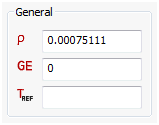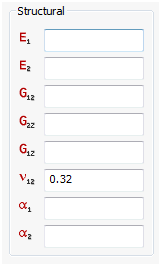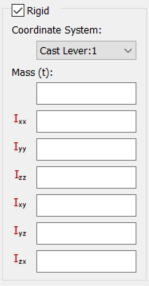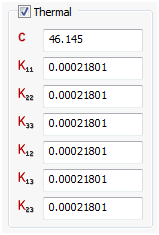After selecting Orthotropic 2D from the Type drop-down, the following material sections will be available: General, Structural, Allowables, Rigid, and Thermal.
-
General

-
Structural

- You can input Young’s moduli, shear moduli, Poisson’s ratio, thermal expansion coefficients, mass density, material damping coefficient, and material reference temperature under the General and Structural section.
- An approximate value for G1Z and G2Z is the in-plane shear modulus G12. If test data is not available to accurately determine G1Z and G2Z, the value to G12 may be supplied for G1Z and G2Z.
- The mass density, RHO, will be used to automatically compute mass for all structural elements.
- To obtain the damping coefficient GE, multiply the critical damping ratio C/C0 by 2.0. If a dominate frequency is not defined for Material Structural Damping (see Dampings section), GE is ignored in transient response analyses.
- TREF and GE are ignored if the orthotropic 2D material is referenced by a composite layup entry.
- TREF is used only as the reference temperature for the calculation of thermal loads in linear solutions. If an initial temperature load is specified, TREF will be ignored.
- Material stability requires that:


If either condition is not met, a warning message will be issued.
-
Allowables

- You can input allowable values for tension in lateral and longitudinal directions, compression in lateral and longitudinal, and shear under Isotropic Allowables section.
- Xt, Yt, and S are required for composite element failure calculations when requested by the failure theory drop-down of the composite layup editor. Xc and Yc are also used, but not required.
- Rigid

- Users can define Rigid only for Explicit Dynamics analysis. If Rigid is checked, then all elements assigned with this material created from the property ID will be bound together as a single rigid body for the analysis. All material properties for the elements will simply be ignored except for the density value.
- When an element block is made rigid, it no longer performs any element calculations (for example, no material stresses or strains are computed). Moreover, the elements of the rigid body do not contribute to the Courant stability limit considerations of the analysis. This can vastly increase the performance of some modes and reduce the total computer time for the analysis.
- Autodesk Explicit will compute the center of mass, total mass and the mass properties (location of center of mass and rotary inertia tensor about the center of mass) of the rigid body automatically for you and compute the rigid body motions of the element block due to any forces acting upon it .
-
Thermal

- For thermal analyses, you can input values for a conductivity matrix, specific heat, and mass density under the Thermal section. Mass density is repeated since it may be a requirement in thermal analysis as well as in structural analysis.
- Kij forms a conductivity matrix.
